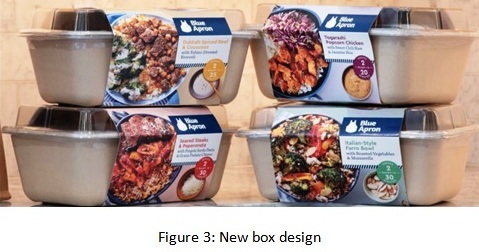The latest trend is having meals delivered to your door. People love the idea of being able to prepare meals for the week without having to do any of the planning. In some instances, it is a cheaper method of going grocery shopping for the week on your own. The meals that are delivered are meals you might not make at home usually due to needing some specialty items sometimes. There are several companies that have this system in place, but it comes with some delivery complications. These complications include the box that the food is in to break down due to condensation, the wastefulness of all of the plastic that is essentially non-recyclable due to the food product still being on the container after being used, and not always being able to locally source ingredients. Meal Kit packaging has many advantages and disadvantages.
The idea of the meal delivery systems came from people watching cooking channels and writing down recipes as they prepare them in the show. Once the show was over not many people were going to the store to get the things needed for that recipe. The ease of access of having possibly the same meals with the same ingredients you were watching being prepared on your television delivered right to your door with instructions included is perfect for someone who loves to cook. Once the customer realizes how much time is being saved in their life, they might decide to continue using this service. That means the non-recycled items that are being used will start to stack up.
Condensation in these packages comes from the ice packs that are included in the box to keep everything cool. But as these boxes heat up the ice pack can not cool off the product anymore, which causes condensation to form on the outsides of these boxes. This causes the boxes to become wet and start to lose this integrity. This can cause the food to possibly spoil before it reaches the customer which is an even greater waste than using everything in the package.

Blue Apron, one of the leaders in meal-kit delivery claims that their materials are all 100% biodegradable to recyclable. The recycling is easier said than done, the tiny baggies are made of low-density polyethylene, a type of plastic that is nominally recyclable, but most cities will not accept it for curbside pickup. The ice packs are only recyclable once you let them thaw, cut off a corner and empty the water-based solution into the trash. The foil is a type of plastic and is non-recyclable. Blue Apron gives you a recycling guide but does not really offer any feasible solutions to someone who does not want to even drive to the grocery store once a week.
Some of the people in the packaging engineering team over at Blue Apron have started to create ways to become more sustainable. Some methods they have started are reducing the size of the ice packs, box optimization by reducing the size by 20%, implementing drain safe gel for the gel packs, using RPET for the tray lids and using less packaging for small amounts of ingredients. The RPET is essentially PET, which is a plastic resin after it has been recycled.
Below are pictures of the old boxes versus the new boxes. They really tried to reduce the size that the meals take up so more can be delivered in one shipment. This is to reduce their carbon emission footprint. Sometimes when the food is not locally available in the areas of their three distribution centers around the United States, they have to outsource products. This causes the carbon emission for just one meal to significantly increase when accounting for all the trips made for just one ingredient.

A few cons about the old box design are that it is larger, has a lot of unoccupied space, and there is a lot of unnecessary extra material to package the smaller ingredients. You are also left with a big empty box after you finish cooking your meal and if you have a meal plan you are left with sometimes several of these boxes every week. The waste of all the items it takes really starts to add up after just a short time of using Blue Apron.

Blue Apron’s packaging engineers took in the considerations and made some changes to the sizes of most of the boxes as well as some other changes for the problems mentioned before. The products in figure 3 are the basic, 2-person meal kits that subscribers can receive per week. This is the most popular meal plan, which in turn is the reason why it needed the biggest sustainability change made to its packaging.
Blue apron is one of the first companies to start the meal kit delivery programs. The overall changes that they have put in place really makes a difference. They are always needing to innovate to stay ahead of the competition. In today’s day and age, people are always looking for the most sustainable method to do things. Blue apron has taken the criticism constructively and made the appropriate changes to please their very large customer base and retain loyal partnership with their providers.
References
Apron, Blue. “Blue Apron: Improvements to Meal Kit Packaging Systems.” SPC, Sustainable Packaging Coalition, 2019, sustainablepackaging.org/blue-apron-improvements-to-meal-kit-packaging-systems/.
Cushing, Ellen. “These Are The Trashy Consequences Of Blue Apron Delivery.” BuzzFeed News, BuzzFeed News, 27 Nov. 2015, www.buzzfeednews.com/article/ellencushing/these-are-the-trashy-consequences-of-blue-apron-delivery
Great, Ash. “Blue Apron Review: Good Eats or Bad Meats?” Personal Finance Made Easy - Banking, Loans, Credit Card Advice | Echeck.org, 28 Nov. 2016, echeck.org/blue-apron-review-good-eats-or-bad-meats/.
Lober, Douglas. “What Is Recycled Polyethylene Terephtalate?” ReuseThisBag.com, Reuse This Bag, 1 Oct. 2019, www.reusethisbag.com/articles/what-is-recycled-polyethylene-terephtalate/.


































